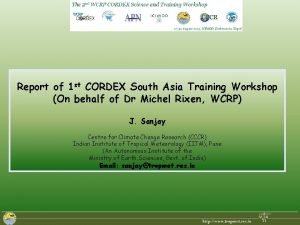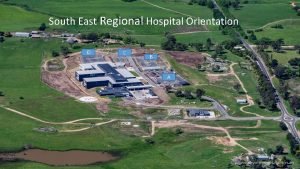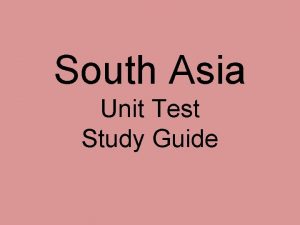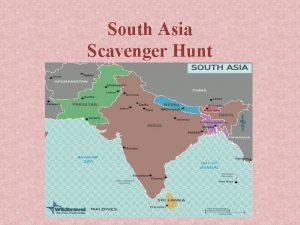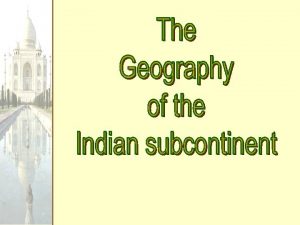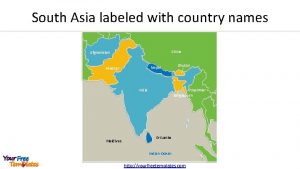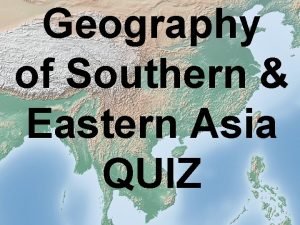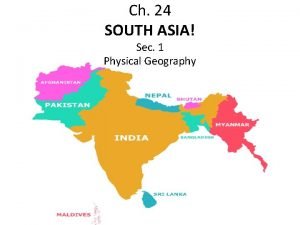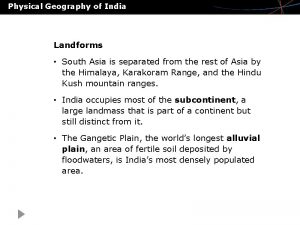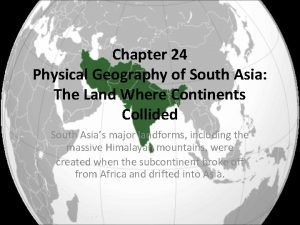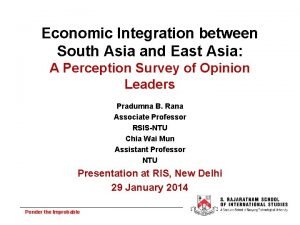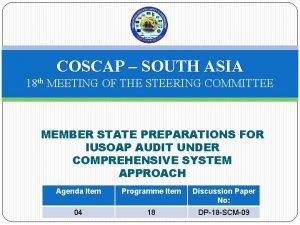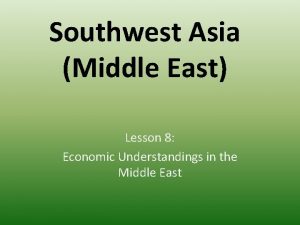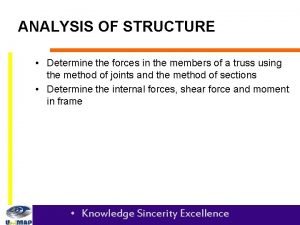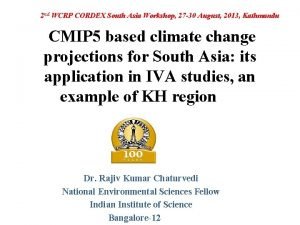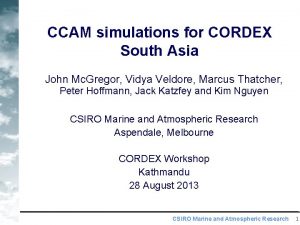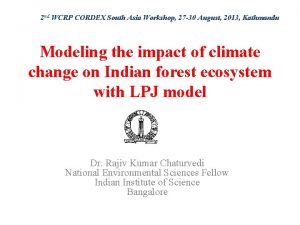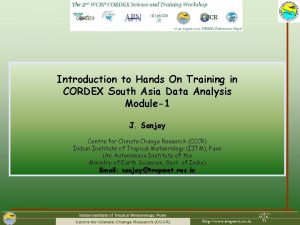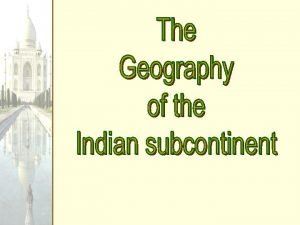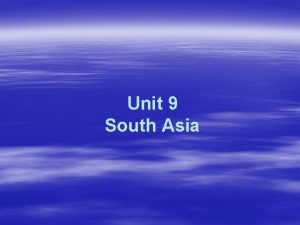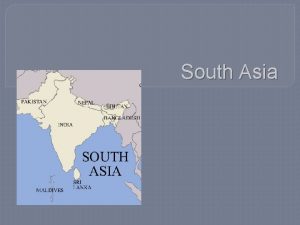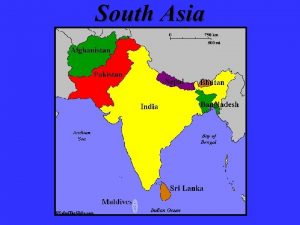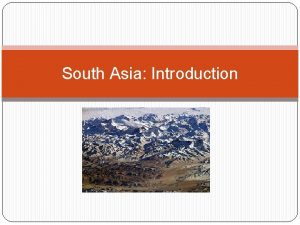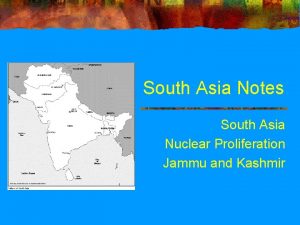CORDEX South Asia A framework for addressing regional





































- Slides: 37

CORDEX South Asia: A framework for addressing regional monsoon issues in a changing climate R. Krishnan, T. P. Sabin, J. Sanjay, M. Mujumdar, P. Priya, M. V. Rama Rao, Sandip Ingle, V. Ramesh, Madhura Kane Centre for Climate Change Research

Regional climate change projections over South Asia Reliable assessment of regional climate change • High resolution is essential to represent processes properly on all ranges of possible statistical outcomes, especially climate extremes and their impacts • Multi-model ensemble simulations necessary for reliable regional climate projections, and to Quantify and reduce uncertainties in regional climate projections Scientific challenges in modeling extreme climate events • Most occur relatively infrequently and are inherently unpredictable • Require large ensembles to simulate the statistics • Assess the impact of external drivers on their statistics • Depend on dynamical processes that require relatively high resolution to represent them

WCRP CORDEX South Asia – led by CCCR, IITM Co-ordinated Regional Downscaling Experiment – CORDEX South Asia

CORDEX: Model Experiments Ø Evaulation / Baseline run with ERA – Interim boundary conditions (1989 – 2008) Ø Historical run (1950 – 2005) Ø Future projection : 2005 - 2100 (eg. , RCP 4. 5, 6. 0, 8. 5 Scenario) Participating Modeling Groups Ø LMDZ model (~ 35 km ) CCCR (IITM), IPSL Ø Reg. CM model (~ 50 km) Ø Had. RM 3 P model (~ 50 km) CCCR (IITM), Hadley Centre Ø WRF model (~ 50 km) - CCCR (IITM), BCCR and TERI Ø MRI model (~ 20 km) global model (MRI, Japan) Ø RCA model (~ 50 km) Rossby Centre, Sweden Ø COSMO-CLM (~ 50 km) University of Frankfurt, Germany Ø CCAM model ( ~ 50 km) CSIRO, Australia CCCR (IITM)

CORDEX-South Asia Multi-Model Output Evaluation Run (1989 – 2008); Historical (1950 – 2005); RCP 4. 5 scenario (2006 - 2100) (To be available by end of September 2013) Variable name (Monthly and Daily) SMHI-RCA 4 Reg. CM 4 GFDL Reg. CM 4 -LMDZ COSMO-CLM LMDZ Rainfall Y Y Y Surface Temperature Y Y Y Maximum Temperature Y Y Y Minimum Temperature Y Y Y Sea-level Pressure Y Y Y Surface Specific Humidity Y Y Y Surface Zonal Wind Y Y Y Surface Meridional Wind Y Y Y Downward Shortwave Radiation Y Y Y

LMDZ grid setup for CORDEX South Asia (shaded region has grid-size < 35 km ) Source: Sabin, CCCR, IITM

Topography (m) and model grids over the Asian region Hindu Kush Western Ghats Himalayas

PRITHVI (High Performance Computing System) , IITM, Pune Configuration of PRITHVI, HPC at IITM: n IBM P 6 575 nodes totaling 117 numbers including the 2 nodes for GPFS quorum and one Login node. Each node is populated with 32 cores of IBM P 6 CPU running at 4. 7 G Hz. Total of 3744 cores with Peak Performance of 70 Tflops. n High end Servers P 570’s, P 550’s, 20 Visual Workstations. n Interconnectivity using Infiniband Switches and Ethernet switches for Management purposes n Total of 3 Peta Bytes of Storage including Online, Near-line and Archival Storage n GPFS, Tivoli and other Management Softwares

Monsoon rainfall (JJAS) Zoom No Zoom Mean annual cycles of rainfall (mm day -1) and surface temperature (o. C) over the Indian landmass from the zoom and no-zoom runs No Zoom

Understanding regional climate change over South Asia High resolution (~ 35 km) dynamical downscaling at CCCR, IITM Historical (1886 -2005): Includes natural and anthropogenic (GHG, aerosols, land cover etc) climate forcing during the historical period (1886 – 2005) ~ 120 years Historical Natural (1886 – 2005): Includes only natural climate forcing during the historical period (1886– 2005) ~ 120 years RCP 4. 5 scenario (2006 -2100) ~ 95 years: Future projection run which includes both natural and anthropogenic forcing based on the IPCC AR 5 RCP 4. 5 climate scenario. The evolution of GHG and anthropogenic aerosols in RCP 4. 5 scenario produces a global radiative forcing of + 4. 5 W m-2 by 2100

Surface Air Temperature RCP 4. 5 Global Mean RCP 4. 5 Global Tropics (30 o. S – 30 o. N) RCP 4. 5 Source: Sabin, CCCR, IITM South Asian Monsoon (70 o. E– 90 o. E; 10 o. N– 25 o. N)

Annual mean precipitation JJAS precipitation Global Tropics (30 o. S – 30 o. N) RCP 4. 5 South Asian Monsoon Region (70 o. E– 90 o. E; 10 o. N– 25 o. N) RCP 4. 5 Source: Sabin, CCCR, IITM

High resolution climate data for regional applications • Regional data products, indices, extreme events • Understanding regional climate processes: Links between regional and large -scale variability - (eg. , Heavy precipitation events and floods, heat waves, etc). • Applications: Climate, Hydrological, Agriculture, Health, Economy • Evaluation using CORDEX multiple models: variability eg. , Patterns of regional rainfall • Impact assessment: eg. , River runoff and discharge using macroscale hydrological models • Training workshops: Develop synergistic linkage between climate downscaling and VIA user communities in Asia through direct user engagement

Regional Climate Products: Examples of Applications Heat wave days Mar-Apr-May (MAM) season w. r. t 90 th percentile 2010 -2020 2050 -2060 2080 -2090 Source: Sabin, CCCR, IITM

Number of days with temperatures exceeding 45°C in MAM season 2050 -2060 2010 -2020 2080 -2090 Source: Sabin, CCCR, IITM

Monitoring Meteorological Drought using Standardized Precipitation Index (SPI) 2002 2005 2026 2. 00 or More Wet 1. 50 to 1. 99 1. 00 to 1. 49 0. 00 to 0. 99 0. 00 to -0. 99 -1. 00 to -1. 49 -1. 50 to -1. 99 -2. 00 or Less Source: Sabin, CCCR, IITM : Extremely : Severely Wet : Moderate Wet : Mildly Dry : Moderate Dry : Severely Dry : Extremely Dry

Trend in consecutive dry day index (JJAS) 2010 -2020 2040 -2050 2070 -2080 Source: Sabin, CCCR, IITM

Trend in number of extreme rainfall (> 100 mm/day) events 2050 -2060 2010 -2020 2080 -2090 Source: Sabin, CCCR, IITM

Regional climate processes: Links between regional and large-scale variability Pakistan Floods 2010: Extent of Pakistan floods detected by AIRS satellite. The Atmospheric Infrared Sounder, AIRS, in conjunction with the Advanced Microwave Sounding Unit, AMSU, senses emitted infrared and microwave radiation from Earth to provide a three-dimensional look at Earth's weather and climate Source: Milind Mujumdar • Westward shift of sub-tropical High (Mujumdar et al. 2012) • Westward displacement of storms and departure of synoptic scale circulation (Houze et al. 2011) • Influence of midlatitude circulation, European blocking and interaction with tropical storms (Hong et al. 2011, Saeed et al. 2011) http: airs. jpl. nasa. gov • Extended range prediction (~ 15 days lead) (Webster et al. 2011) Climatology 2010

Uttarakhand (India) floods 2013 200 h. Pa winds 14 -18 June 2013 Courtesy: Sir Prof. Brian Hoskins

Evolution of Uttarakhand heavy rainfall event (June 2013) Interactions between southward intruding mid-latitude troughs and monsoon lows L 14 June 2013 16 June 2013 L 15 June 2013 17 June 2013 Courtesy: Ramesh Vellore

Flood Inundated Areas in part of Assam State: 8 June 2012 - Analysis of Radarsat SAR data Flood Hazard Zonation Map of Brahmaputra and Barak Rivers in Assam State – Based on analysis of satellite data during 1998 – 2005 floods Courtesy: National Remote Sensing Centre, India

Rainfall over the southern slopes of the Himalayas & adjoining plains during monsoon breaks (Dhar, Soman and Mulye, 1984) Composite during breaks (Ramesh et al. 2013 Under review) Rainfall anomaly Anomalous northward shift of monsoon trough Ramesh et al. 2013

Monsoon break simulation by WRF high-resolution (10 km) model - Courtesy: Ramesh Vellore SLP and 850 h. Pa winds Precipitable water Day 0 Day 1 500 h. Pa Geopotential height and winds Day 0 Rainfall Day 1

High resolution improves rainfall simulation over central-eastern Hiimalayan foothills during monsoon breaks – Ramesh et al. 2013

Simulated annual mean precipitation climatology (1990 -2004) bias (mm/d) against the CRU data for 10 CMIP 5 AOGCMs and their ensemble mean. Table 2: Subset of CMIP 5 AOGCMs. Model CMIP 5 Model Horizontal Label Name Resolution C 1 Can. Esm 2 2. 8 X 2. 7 C 2 GFDL-CM 3 2. 5 X 2. 0 C 3 GFDL-ESM 2 M 2. 5 X 2. 0 1. 125 o x 1. 125 o C 4 EC-EARTH C 5 Had. CM 3 3. 75 X 2. 5 C 6 Had. GEM 2 -ES 1. 875 x 1. 25 C 7 IPSL-CM 5 A-LR 1. 875 x 3. 75 C 8 MIROC 5 1. 4 x 1. 38 C 9 MPI-ESM-LR 1. 875 x 1. 865 C 10 MRI-CGCM 3 1. 125 x 1. 121 Courtesy: J. Sanjay

Simulated surface air temperature (o. C) annual cycle for the 10 selected subregions (a-j) over South Asia. The ensemble mean (thick lines) and range (shading) are shown for CMIP 5 (green), RCMs driven with ERAI (blue) and RCMs driven with CMIP 5 (red) Subregion Label Description Location R 1 R 2 R 3 R 4 R 5 R 6 R 7 R 8 R 9 R 10 Central India (CLI) South West India (SWI) South East India (SEI) North Pakistan and India (NPI) South Pakistan and India (SPI) Nepal (NEP) Bangladesh (BLH) Bhutan (BTN) Srilanka (SLA) Myanmar (MNR) 79 o. E-85 o. E; 20 o. N-26 o. N 73 o. E-76 o. E; 11 o. N-21 o. N 77 o. E-80 o. E; 8 o. N-16 o. N 70 o. E-80 o. E; 30 o. N-35 o. N 65 o. E-75 o. E; 23 o. N-30 o. N 80 o. E-89 o. E; 26 o. N-31 o. N 88 o. E-93 o. E; 20 o. N-27 o. N 88 o. E-93 o. E; 26 o. N-29 o. N 79 o. E-82 o. E; 5 o. N-10 o. N 92 o. E-101 o. E; 9 o. N-28 o. N Courtesy: J. Sanjay

The simulated precipitation (mm/day) annual cycle in the 10 selected subregions (a-j) over South Asia. The ensemble mean (thick lines) and range (shading) are shown for CMIP 5 (green), RCMs driven with ERAI (blue) and RCMs driven with CMIP 5 (red) Courtesy: J. Sanjay

Patterns of rainfall variability over Himalayas from multiple models APHRODITE LMDZ SMHI COSMO-CLM Source: Priya, CCCR

Macroscale Hydrological Modeling Ø Macro-scale hydrological models(Liang et al. 1994, 1996) are powerful tool to Understand assess hydro-climatic variability and flood processes on a river basin scale (Arnell 1999 b, Nohara et al. 2006). Ø Predict the river discharge at un-gauged stations Ø Variable Infiltration Capacity (VIC) at 0. 125 x 0. 125 degree resolution The key characterestics of VIC are • Subgrid variablity in land- vegetation classes. • Subgrid variability in soil moisture storage capacity • Subgrid variability in topography with use of elevation bands. Meteorological inputs (precipitation, temperature and windspeed) are given to VIC model as daily time-series. Land-atmosphere fluxes and water and energy balances are simulated at daily time steps. Daily runoff and baseflow from VIC model is routed using separate routing model (Lohman. et al. 1996) Source: Deepashree Raje and Priya, CCCR VIC network Routing Model 30

Analysis of extreme precipitation 2010 Pakistan floods eg. , Gumbell Distribution The distribution toward which the sampling distribution of largest values converge is called Generalized Extreme Value (GEV) Distribution. Gumbell distribution is a special type of GEV Distribution, generally known as EV Type I distribution and it has two parameters. location Parameter Source: Priya, CCCR, IITM scale parameter

Macroscale Hydrological Modeling: Indus Basin Attock 03/15/12 Source: Priya, CCCR, IITM

0. 7 0. 64 Nash-Sutcliffe Efficiency (Nash and Sutcliffe(1970) Without 1974, NSE = 0. 723 Full Period , NSE = 0. 709 Global River Discharge (GRD) database Source: Priya, CCCR, IITM

WCRP CORDEX South Asia Training Workshop In partnership with CCCR-IITM, START, ICTP, CSAG, SMHI and ICSUROAP 17 – 20 October 2012, Pune, India http: //cccr. tropmet. res. in/cccr/home/CORDEX/oct 2012/index. ht ml


Summary • Generation of CORDEX South Asia multi-model simulations at IITM and Partner Institutions Evaluation run, Historical runs and future scenarios eg. RCP 4. 5. • Multi-model approach to quantify uncertainties in regional climate projections • Development of regional capacity - CORDEX training workshops proposed to be held in South Asia, East Asia and South East Asia in 2013, 2014 and 2015 • Standardize the format of CORDEX South Asia model outputs from multi-model ensemble simulations • Archival, management and sharing of CORDEX South Asia model outputs - Mechanism to consolidate model outputs from all partner institutions • Framework for developing an ESG node at CCCR, IITM for CORDEX South Asia • Framework for Evaluation of CORDEX South Asia model simulations • Develop synergistic linkage between climate downscaling and VIA user communities in Asia through direct user engagement

 Cordex dx
Cordex dx Flat addressing vs hierarchical addressing
Flat addressing vs hierarchical addressing South delta regional housing authority
South delta regional housing authority North central texas regional certification agency
North central texas regional certification agency South east regional hospital
South east regional hospital South west asia and north africa map
South west asia and north africa map South asia unit test
South asia unit test South asia scavenger hunt
South asia scavenger hunt South asia satellite
South asia satellite Physical features map of south asia
Physical features map of south asia South asia map and capitals
South asia map and capitals South asia physical features
South asia physical features Reteaching activity 24 cultural geography of south asia
Reteaching activity 24 cultural geography of south asia South asia map ganges delta
South asia map ganges delta South asia physical features map
South asia physical features map Europe vs asia
Europe vs asia Geography of sw asia color by number
Geography of sw asia color by number South asia landforms
South asia landforms Arya south asia 46m 14msinghtechcrunch
Arya south asia 46m 14msinghtechcrunch South asia physical geography
South asia physical geography Engineering mechanics statics in si units
Engineering mechanics statics in si units South asia
South asia Coscap south asia
Coscap south asia Lesson 8 middle east and south asia
Lesson 8 middle east and south asia Chapter 25 human geography of south asia
Chapter 25 human geography of south asia Pearson education south asia pte ltd
Pearson education south asia pte ltd Old south vs new south streetcar named desire
Old south vs new south streetcar named desire Formuö
Formuö Novell typiska drag
Novell typiska drag Tack för att ni lyssnade bild
Tack för att ni lyssnade bild Vad står k.r.å.k.a.n för
Vad står k.r.å.k.a.n för Varför kallas perioden 1918-1939 för mellankrigstiden
Varför kallas perioden 1918-1939 för mellankrigstiden En lathund för arbete med kontinuitetshantering
En lathund för arbete med kontinuitetshantering Kassaregister ideell förening
Kassaregister ideell förening Vilotidsbok
Vilotidsbok A gastrica
A gastrica Förklara densitet för barn
Förklara densitet för barn Datorkunskap för nybörjare
Datorkunskap för nybörjare
